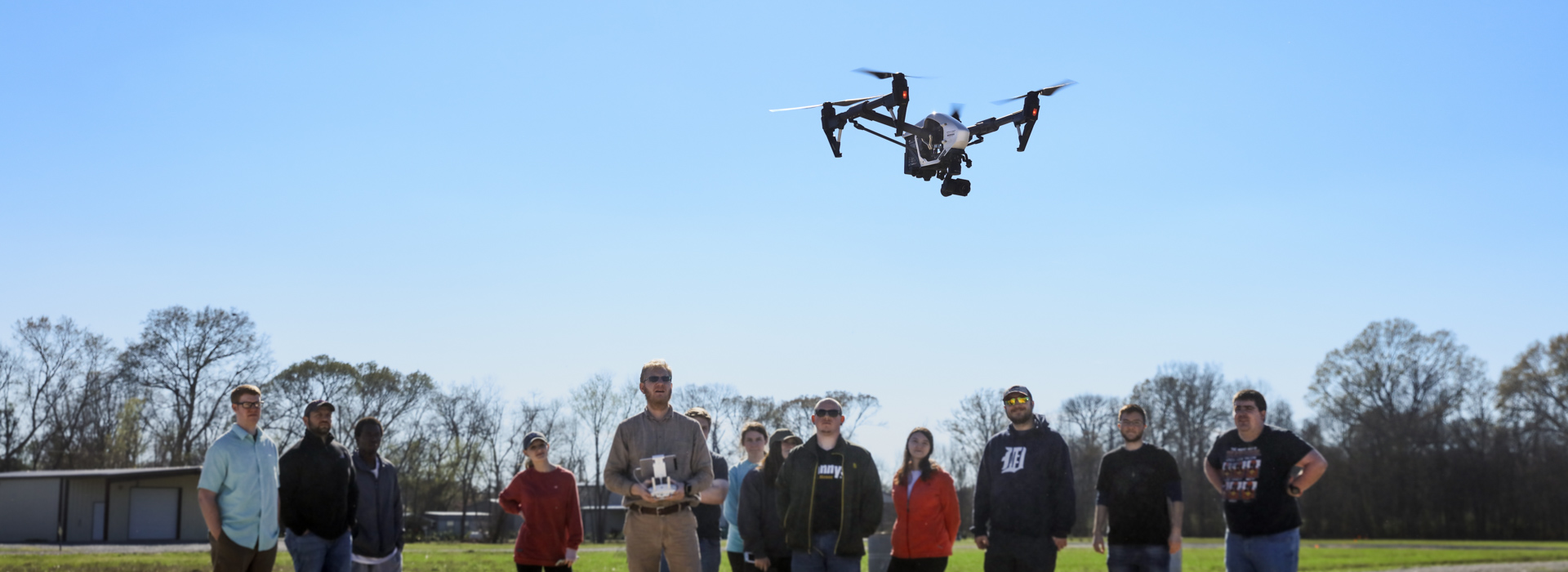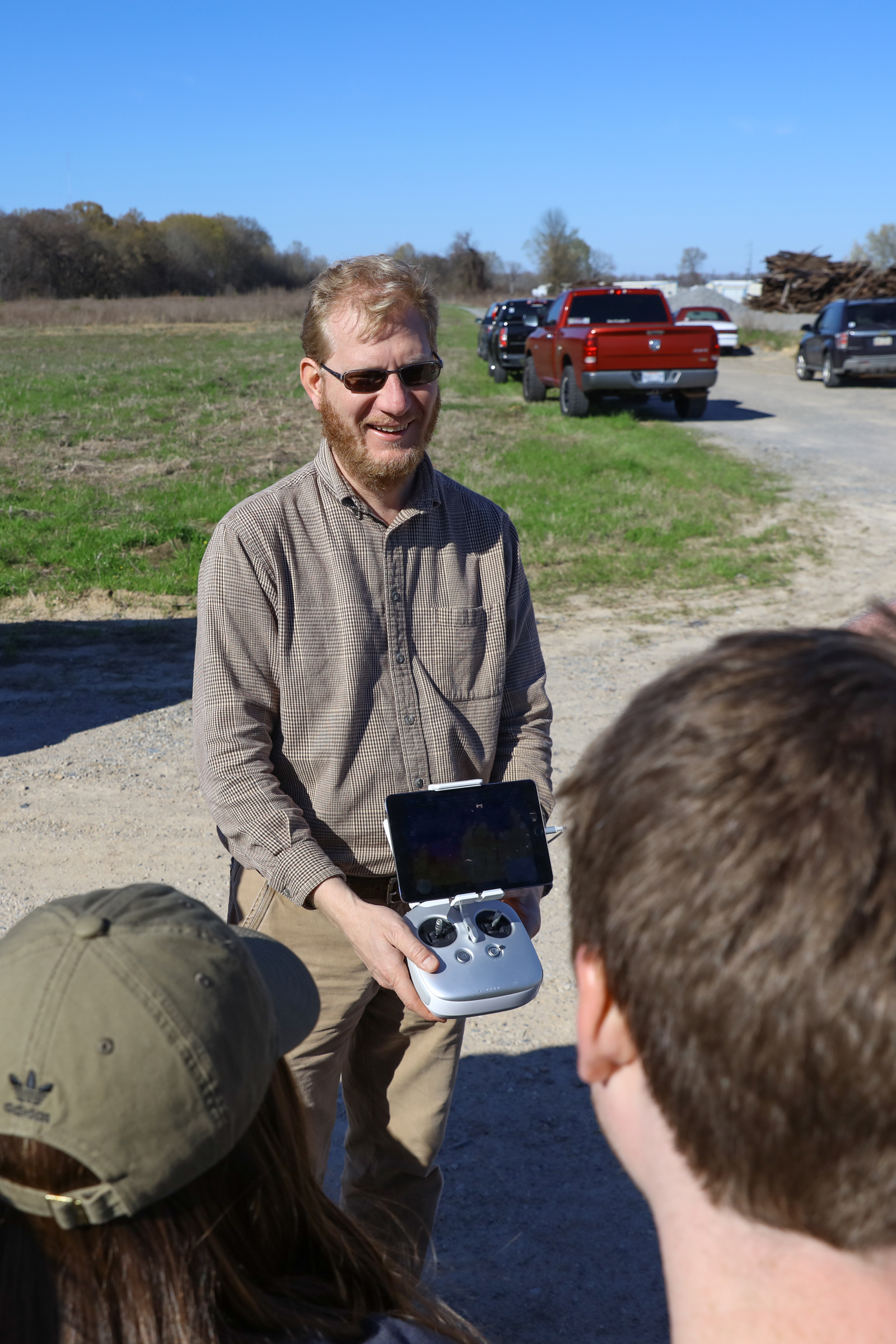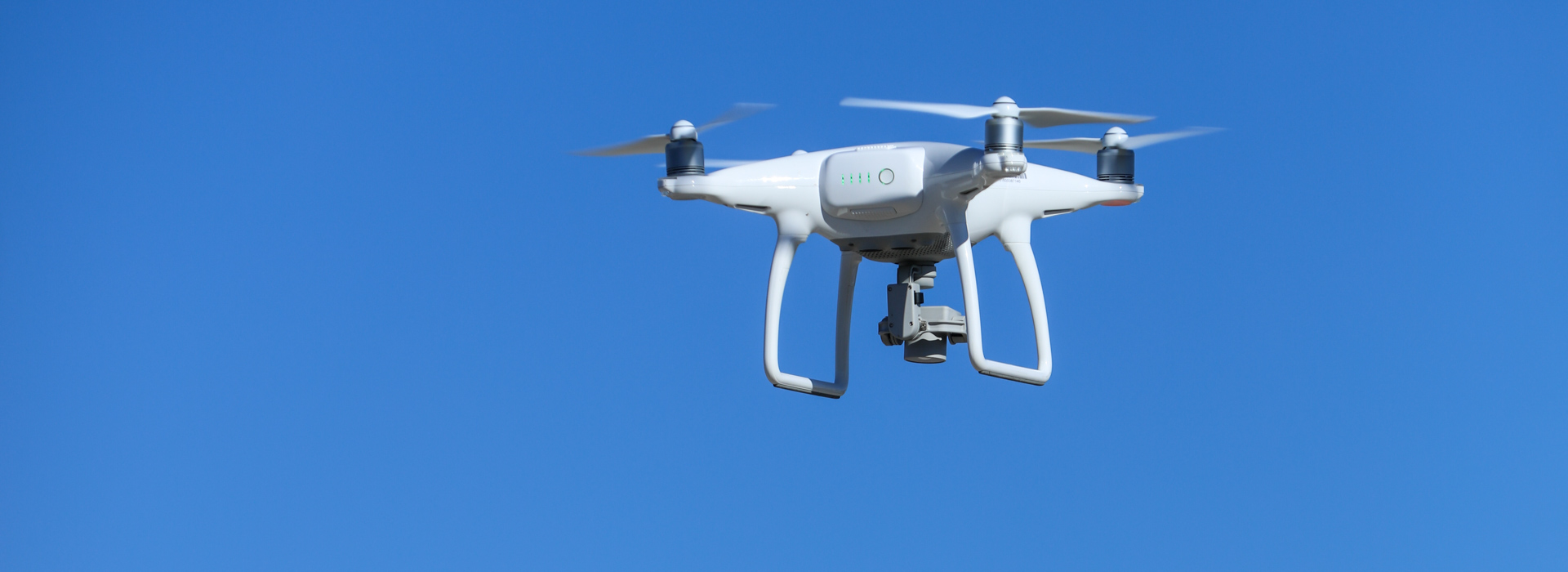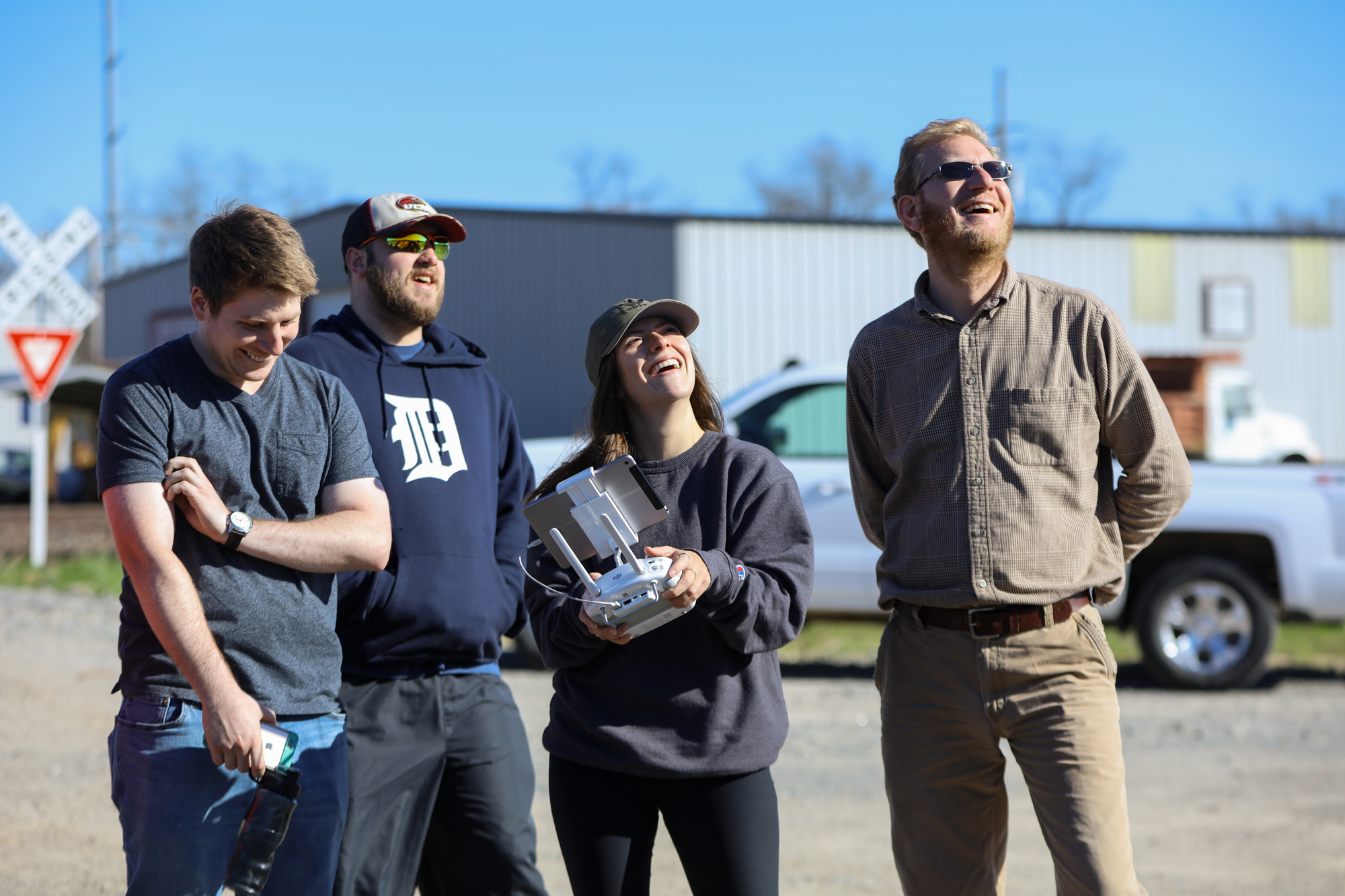Published April 12, 2018
By Mark Henderson
Special to Marketing and Communications
A small unmanned aircraft with multiple propellers flies over a privately owned farm
near Sterlington. Suddenly, it hovers feet above a field of soybeans.
Its mission: To capture vital information concerning the health of the crop.
Photos by Emerald McIntyre/ULM Photo Services
For three years, two University of Louisiana Monroe faculty members have flown drones
over the same piece of property.
One, a geographer, conducts research. The other, an aviator, puts his years of flight
experience, many in the Air Force, to use operating and teaching the new technology.
Together they have blazed a trail that holds benefits for both farmers in the field
and students in the classroom.
The work of Dr. Paul Karlowitz, associate professor of aviation, and Dr. Sean Chenoweth,
assistant professor of geosciences, is yielding information that would empower growers
to practice precision agriculture, saving them time and money.
The size of the average farm has grown through the years. It’s difficult, Chenoweth
says, for farmers to know exactly what’s happening on all the acreage at any one time.
Farmers often choose the easiest route and treat all of their land with fertilizer
and chemicals.
The problems, however, usually are isolated – weeds over here, too much water over
there. The alternative to expensive blanket treatment has been walking the rows of
crops looking for problems – an inefficient use of time.
Chenoweth’s research proposes answers.
Eye in the sky
Chenoweth uses an assortment of cameras attached to the drones to determine the health
of the crop. One of the cameras reads infrared reflection.
“You can see a vegetation’s health,” Chenoweth said. “Healthy plants let off more
infrared radiation, pinpointing where in the field crops may be suffering.”
When data from the camera is downloaded on computer, darker areas of the field indicate
healthier plants.
“If there’s a problem with a crop, the reduced radiation given off can provide a warning
two weeks before the eye can detect it,” Chenoweth said.
Another camera, which measures heat, can help a farmer determine the wetness of the
soil across his fields, allowing him to make precision decisions on questions of irrigation.
Isolate the problems, save time and money.
Chenoweth shows infrared screen to class.
Once, Karlowitz used a quad-propeller drone, flying on a late afternoon, to locate
20 to 30 feral hogs bedding down in a farmer’s field. The hogs had eaten several acres
of corn. The drone told the farmer exactly where to find the hogs.
Recently, ULM added a hyperspectral camera to its arsenal. The camera attached to
the eight-propeller drone can provide so much data, Chenoweth says, that it “takes
hours to download.”
A seven-minute flight can provide 60 gigabytes of data, Karlowitz said.
This new camera can differentiate species of plants.
“Each plant has a reflective signature, like a fingerprint,” Chenoweth says. “You
can tell the sex of trees, and what specie of tree you have.”
The technology can also help farmers determine where they might have weed issues,
Karlowitz says.
“Pigweed is hard to kill. Hyperspectral data can pinpoint where that pigweed is in
the field,” Karlowitz says. “That cuts down costs and time because the farmer doesn’t
have to treat his entire acreage.”
The technology also could prove valuable to law enforcement, Karlowitz says. A drone
can fly over a field where police might suspect marijuana is being grown among other
crops, and the reflective signature can spot it quickly.
Chenoweth is using the information gathered by the numerous drone flights for long-term
research. He’s studying how short-term atmospheric conditions affect the field with
an eye toward climate change.
He now has three years of data available from that soybean field near Sterlington,
but with each generation of technology, the data at his fingertips expands. Over time
he’ll be able to compare weather conditions of one year to another, and how that played
out in the field.
Although the research points to how the technology can guide farmers to do their jobs
more efficiently, Chenoweth says drones have not been put to use yet in northeastern
Louisiana for many reasons.
On the cutting edge
A DJI Phantom 4 is flown over a field with it's camera aimed straight down.
The biggest hurdle is money, Karlowitz says. A farmer would have to invest in at least
one drone, the cameras, software programs, a powerful computer and drone insurance.
“A farmer wants to know what’s the average cost per acre, but that information just
does not exist yet,” he says.
Drones could not be put to commercial use until just recently, when the Federal Aviation
Administration released its rules governing their use. Previously, drone operators
had to have a pilot’s license and file flight plans, so when Chenoweth needed to gather
research, he relied on Karlowitz to operate the drone. Under the new rules, the FAA
created a special license classification for drone operators, known as a Part 107
license. Because the rules are so new, there has not been sufficient time for many
to study and take the exam.
The test consists of 60 questions drawn from a manual of 600 questions and answers
covering such things as rules of restricted airspace. It costs $150 to take the test.
“Most farmers don’t want to study to take such a test, there’s no time,” says Chenoweth,
who recently received his license and can fly the drone on his own now. The same is
true about learning the ever-sophisticated software to optimize the use of data.
Karlowitz adds that the license only indicates you know the rules governing drone
usage. A person can earn a license without ever having flown a drone. Flight training
is additional cost and effort.
Embracing the coming wave
Students take turns flying a drone under Chenoweth's supervision.
What might be cost prohibitive for individual farmers, however, provides opportunity
for ULM students.
With the FAA releasing drones to commercial use, ULM is hoping to claim its niche
in the emerging technology. Currently, ULM offers a concentration on drones within
its general aviation program. In the fall, the university will offer a degree in Unmanned
Aircraft Systems Management.
For ULM students, they will have an advantage in the market because large universities
are just getting into the field, Karlowitz says.
Karlowitz sees the day a ULM graduate can invest in the technology and contract with
many farmers to provide the service, recovering costs through many clients.
Although ULM has invested much effort in using drones for agricultural research, and
those efforts will provide opportunities to train UASM students in flying drones,
the potential uses go far beyond Chenoweth’s research, Karlowitz said. Among the possibilities:
- Replacing crop-dusters with precision spraying.
- Real estate surveying.
- Plant inspections, seeking hazardous material leaks.
- Laser 3D mapping
- Levee inspections
- Pipeline inspections.
“One of our graduates who has his FAA drone license was hired by Dow Chemical. They
said he had all of the skills they were looking for,” Karlowitz says.
Growing exposure
The research efforts also are being incorporated into ULM’s agribusiness studies.
Dr. Zach Moore, director of ULM’s agribusiness program within the College of Business,
says students are required to take a class on how the drones are being used by Chenoweth
and Karlowitz.
“We have a little motto we developed here. Put business in agribusiness. We want our
students to be exposed to the precision technology. They take the course so that they
know what the technology can do for you,” Moore said.
“It’s a managerial tool, and we expect the students to use the information to make
good decisions, how it can lower the cost by using prescriptive rather than blanket
methods.”
Moore says about 30 percent of the agribusiness students will go back to the family
farm. The others intend to use their agribusiness degree to enter banking, real estate
or commodities trading. They will still be introduced to the drones and their data.
“For instance, an ag lender needs to know how a customer’s business works. It’s important
to have an ability to understand what’s going on on the other side of the desk to
best serve them,” Moore says.
For Karlowitz, who is busy developing the curriculum for the new UASM program, it’s
an exciting time. “It’s an emerging technology that is changing so fast. It will be
our job to train students on how to fly and help researchers in their work.”
And help farmers easily see the details hidden in the hundreds of acres – treat those
weeds over here, cut down on the water over there.




